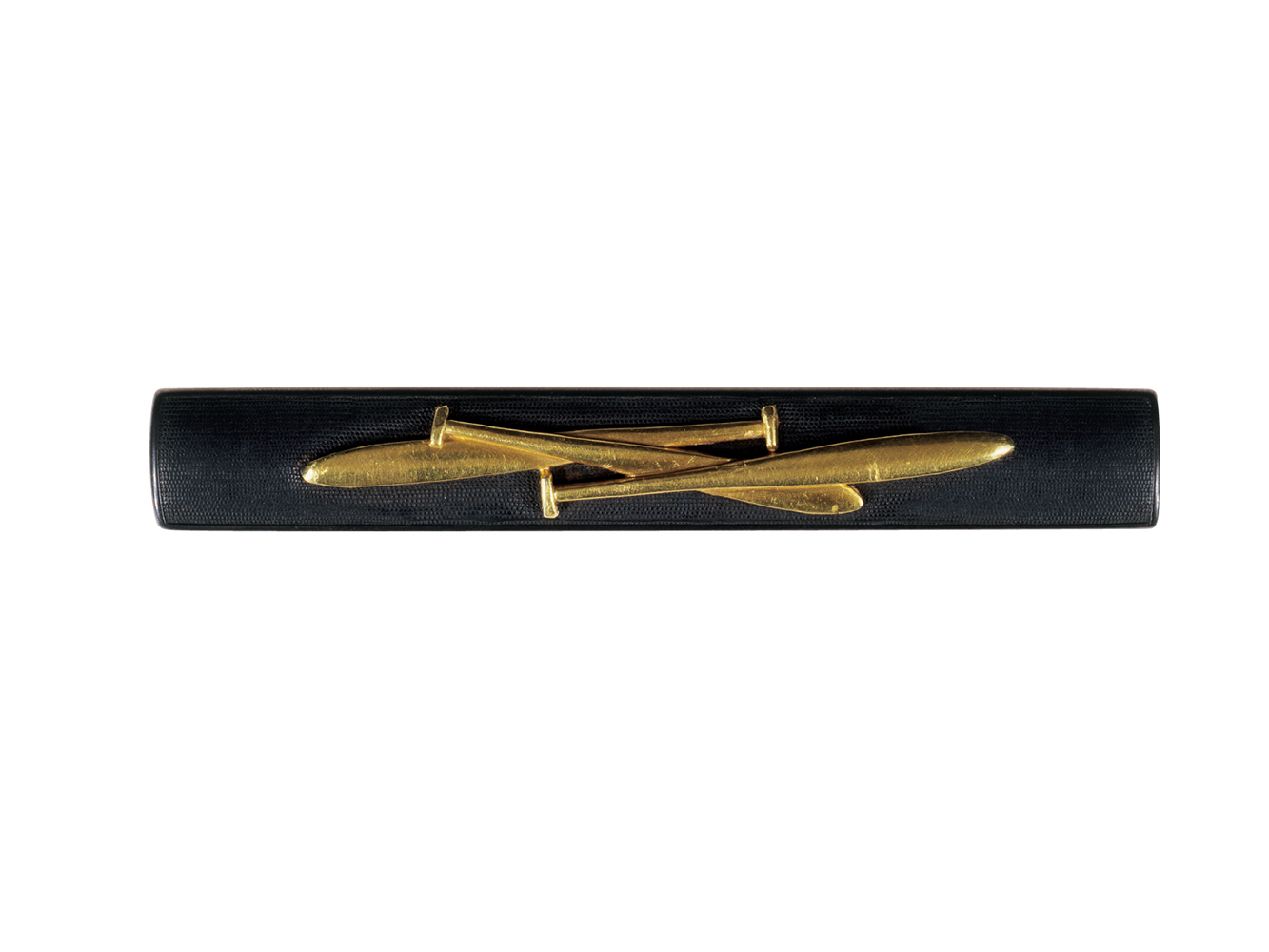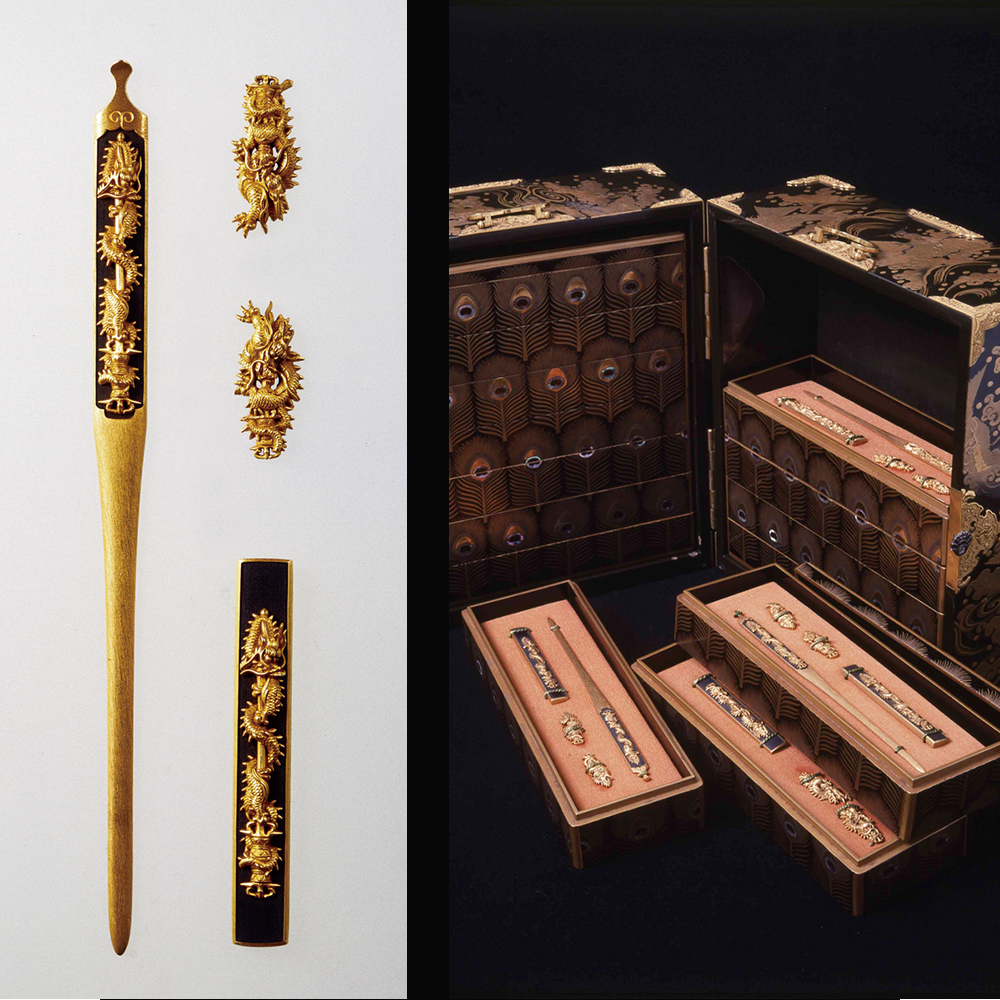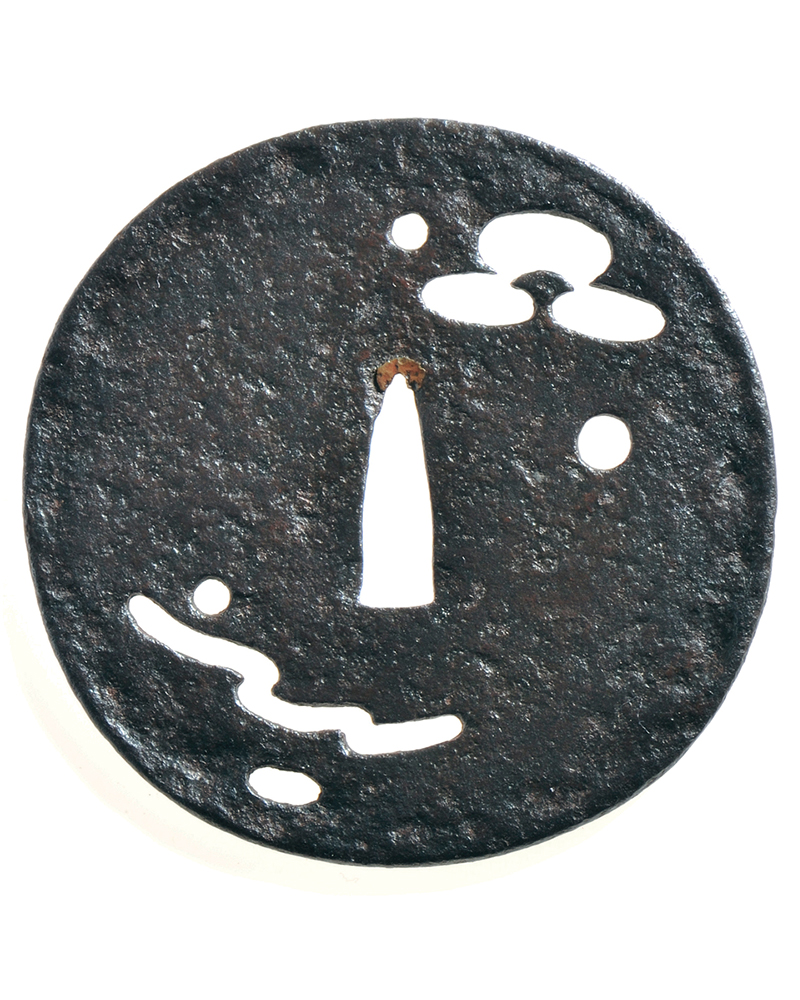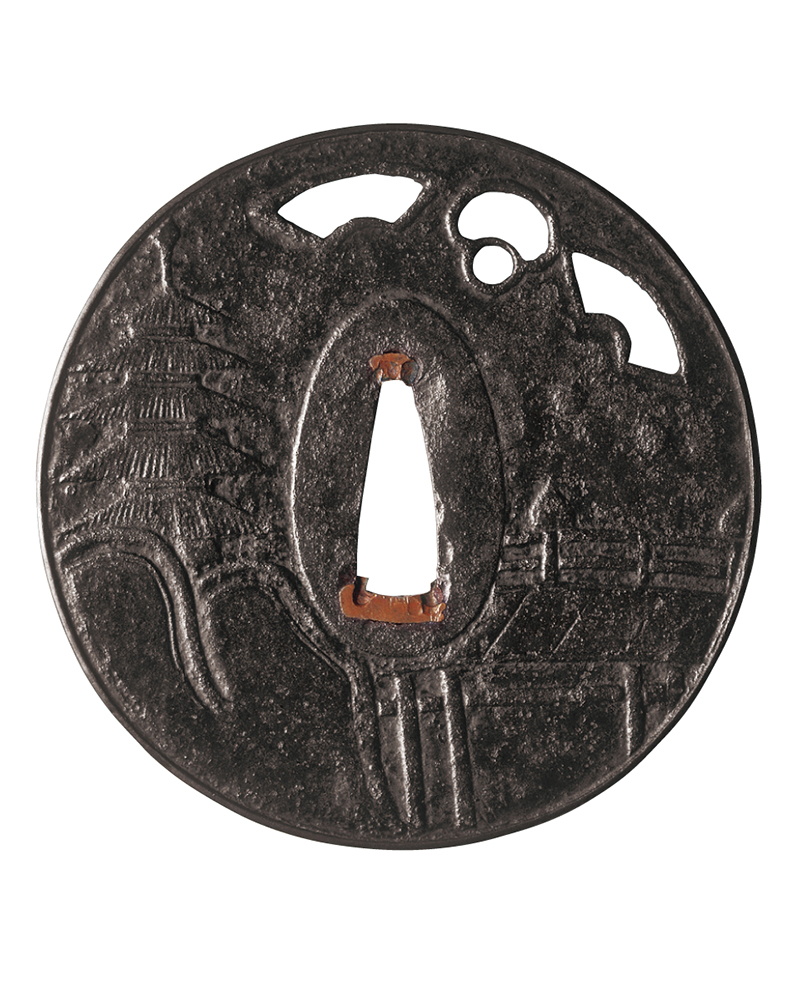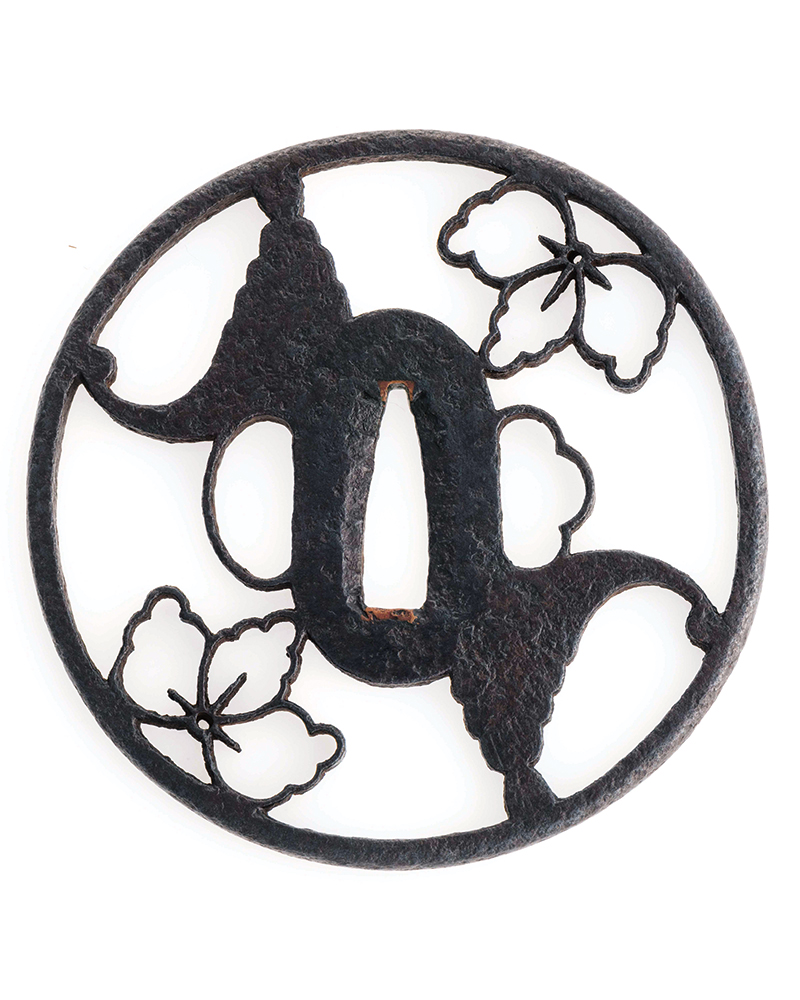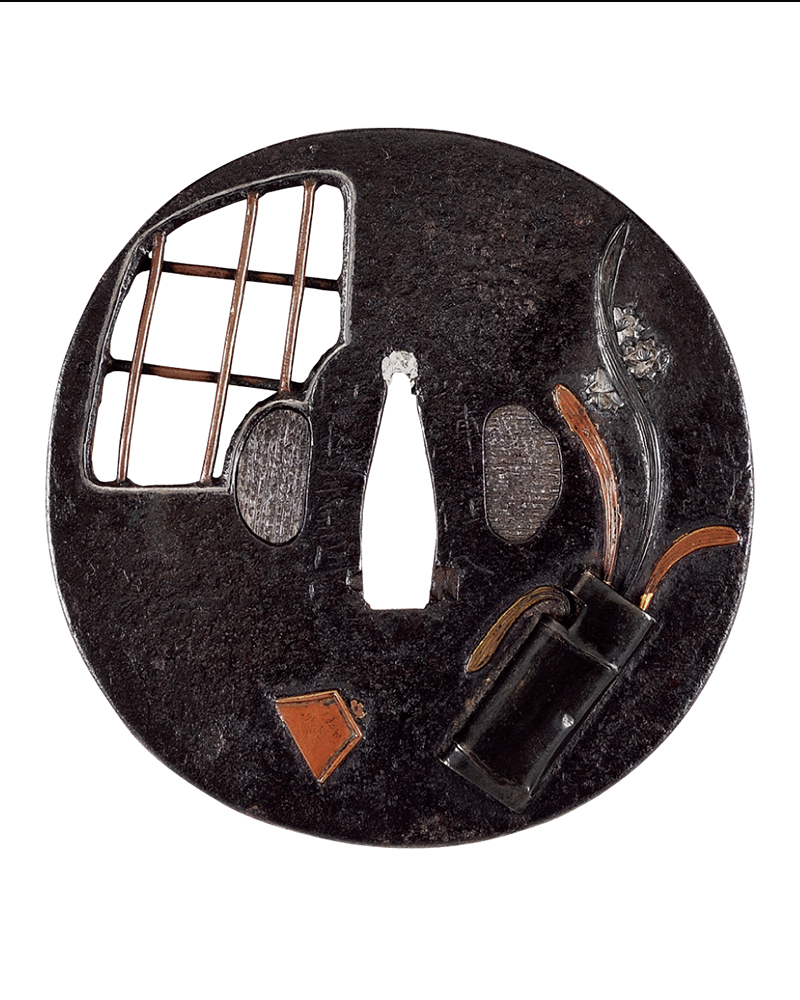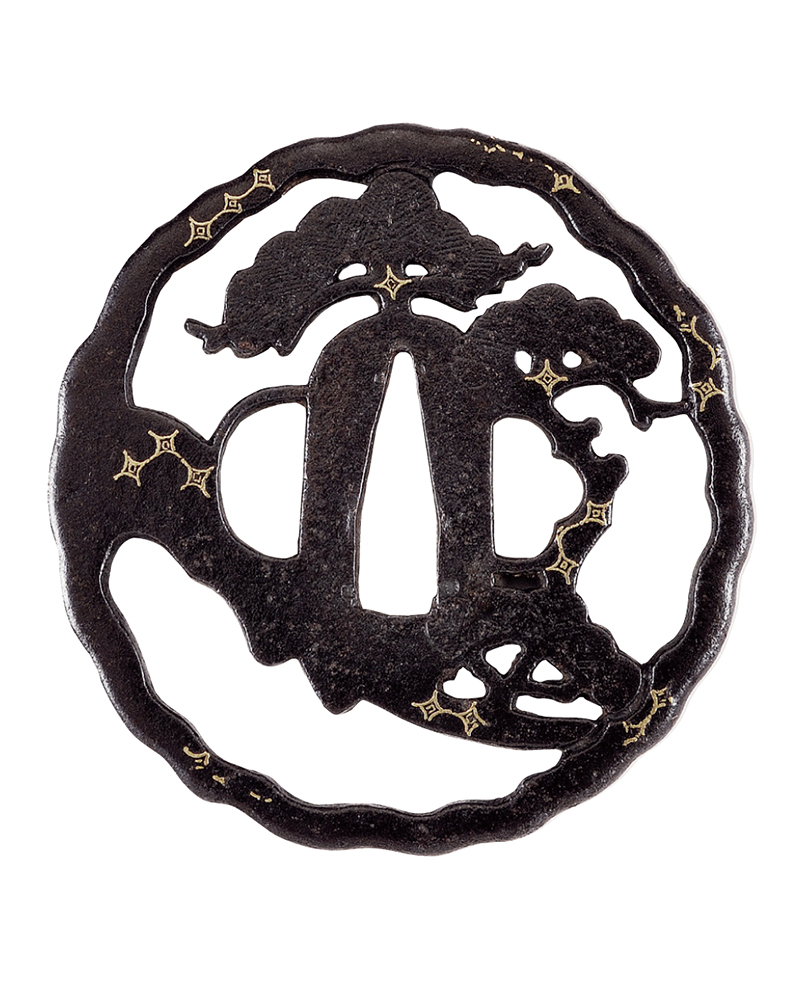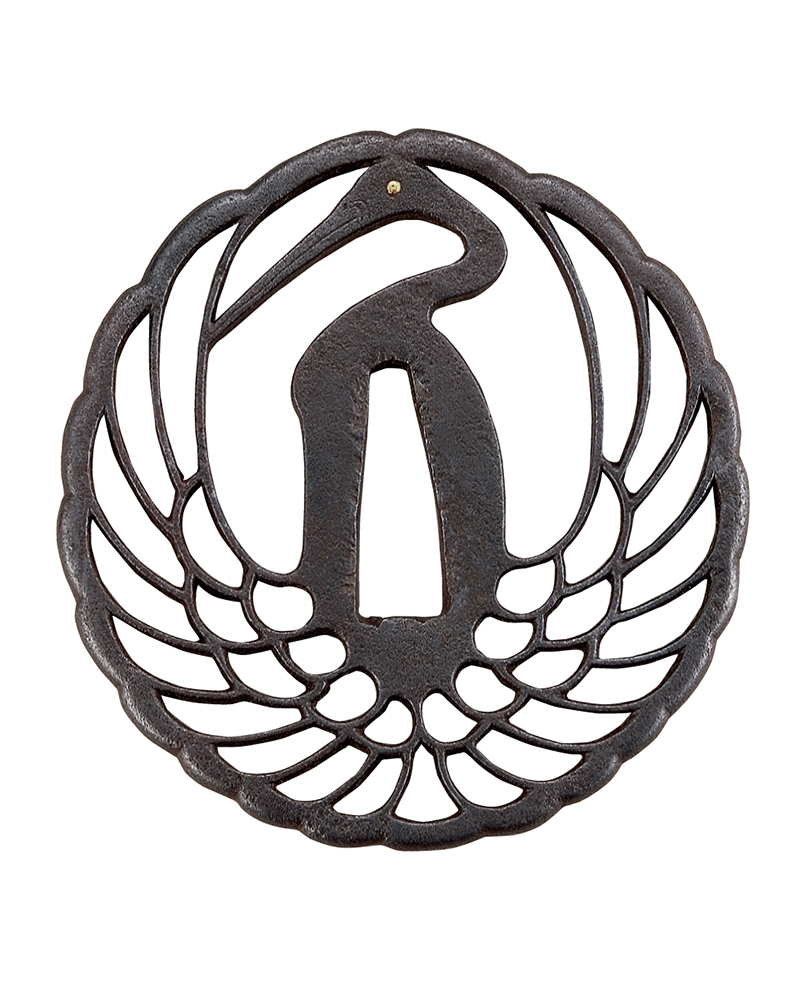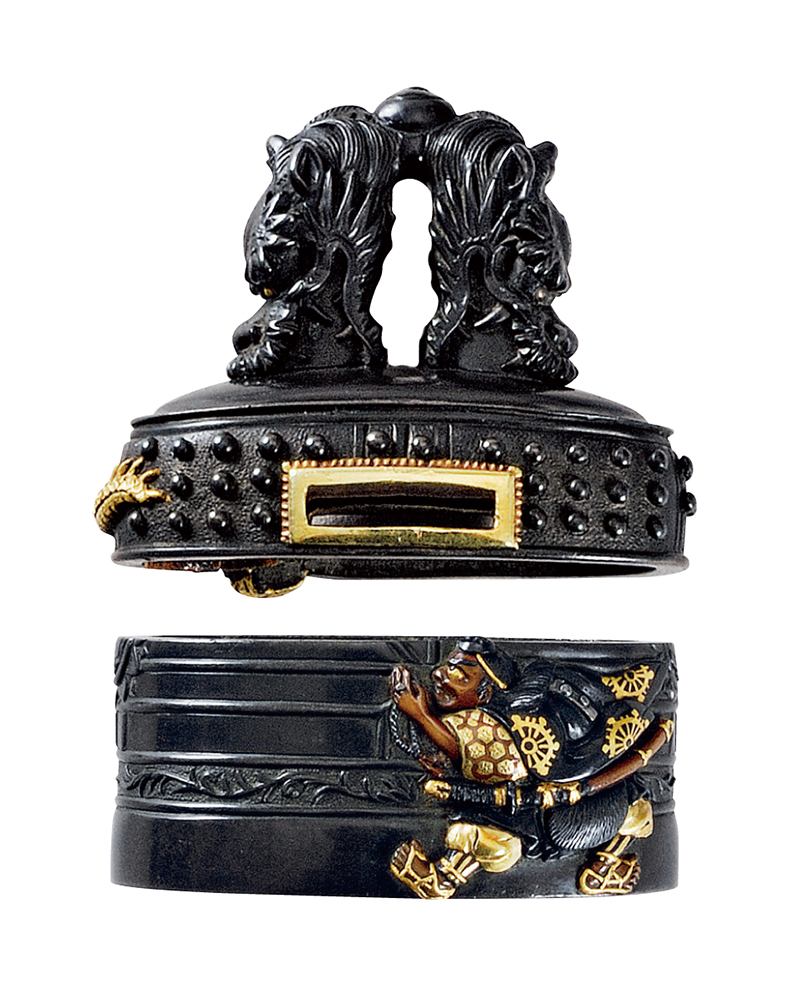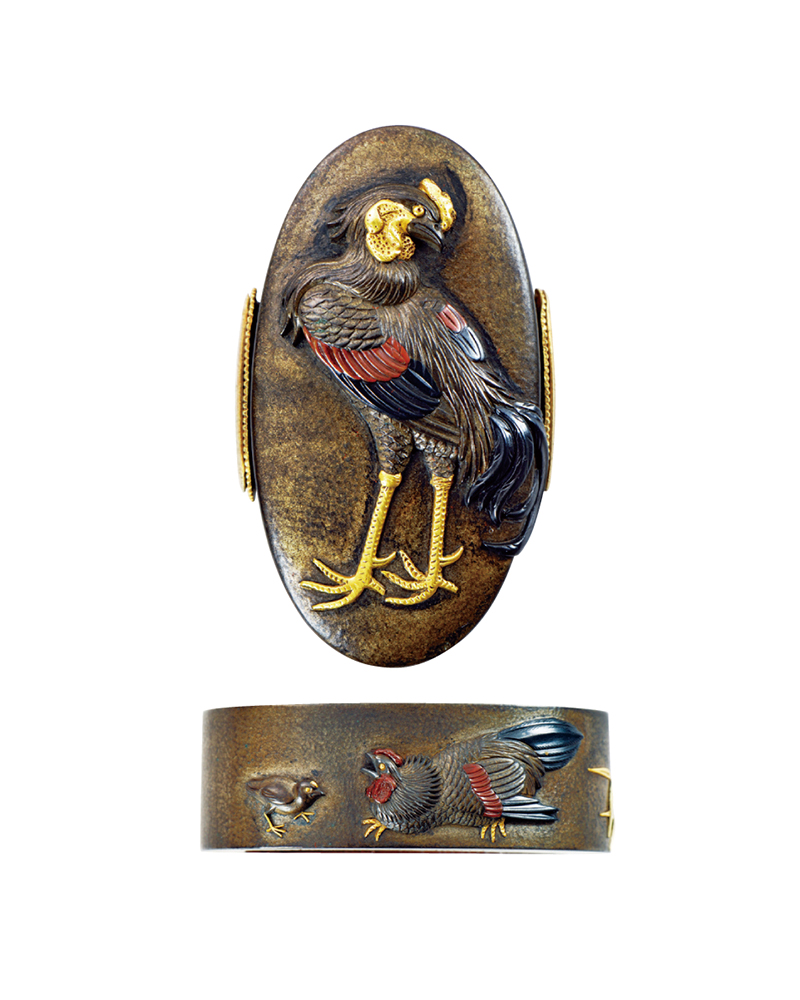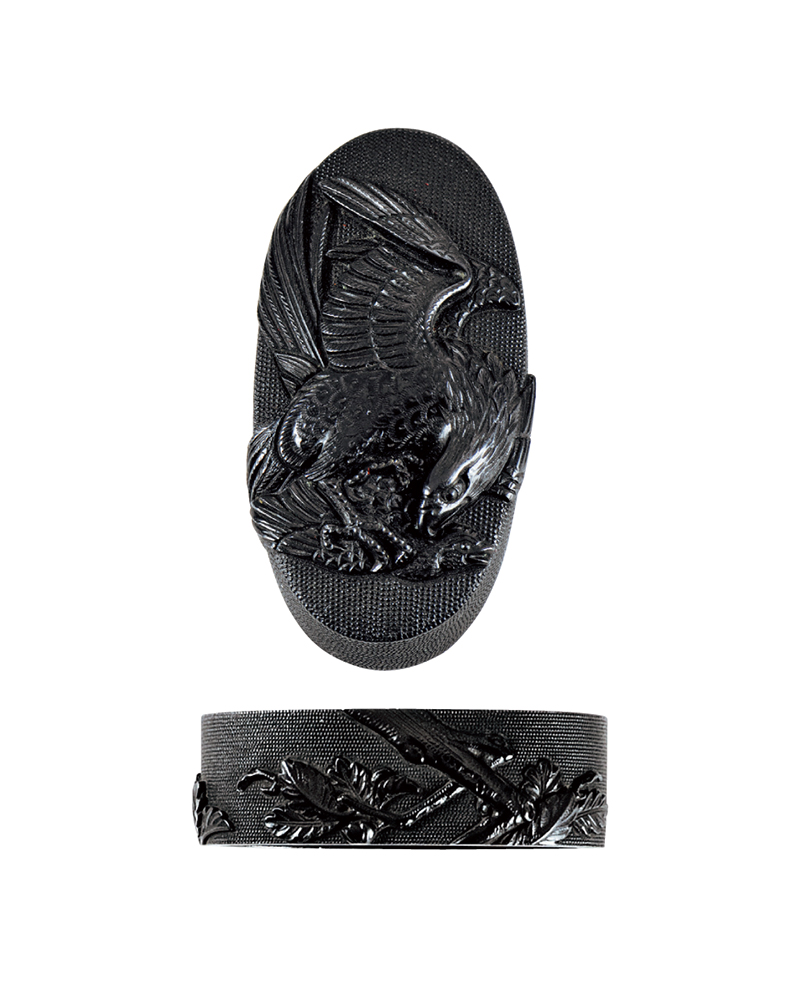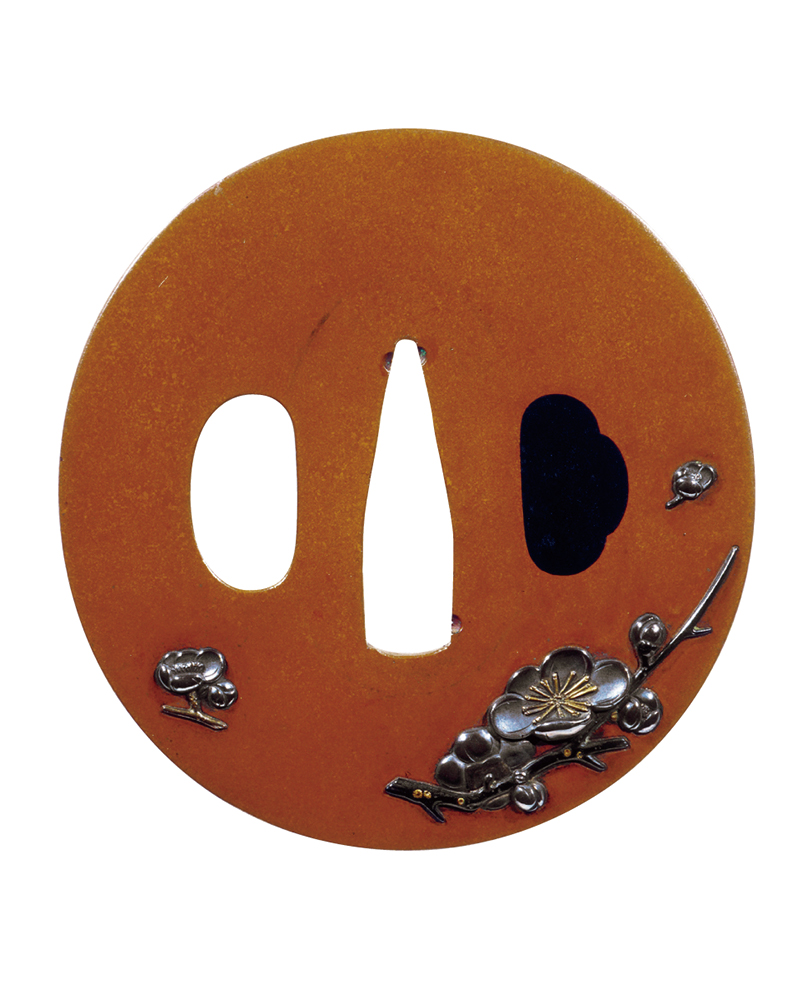Small porch design, inscribed by Yujo, Mitsumasa (signature)
(The author of the famous novel "Kaizokuzuka" by Mitsumasa (Kao))
author
Yujo Goto
Years of birth and death
1440–1512
Country
Japan
Era
Muromachi period (16th century)
Traits
Shakudo fish koji pattern
Number of members
1 share
Law
Length 9.7 cm
Commentary
Kozuka is the handle of a small knife attached to a koshirae. It has three gold oars on a shakudo fish roe base. It has the signature of the ninth generation of the Goto family, Noriyoshi Mitsumasa. Goto Yujo is the ancestor of the prestigious Goto family of metalwork. He left Mino Province to Kyoto and served the Ashikaga Shogunate. With his high engraving skills and refined style, he established the prestige of the Goto family, which continued until the end of the Edo period. The box has an inscription by Kano Natsuo.
A set of metal fittings from the 14th generation of the Goto family (three Kurikara dragons)
(Gotoukeju 14th set of Kanagu (Kurikara Ryumi Tokoromono))
author
The first head of the Goto family, Yujo Goto, and his successors up to 14 generations
Country
Japan
Era
Muromachi period (16th century)
Number of members
14 sets, 1 set
Commentary
A set of menuki, kozuka and kogai is called sanshomono. This item is a set of Kurikara-ryu sanshomono belonging to a feudal lord from the first Goto lord Yusho to the 14th Goto lord Keisho, and was collected by the Toba Inagaki family.
Tsukikage Transparent Tsuba Unsigned Armorer
(Tsukikage Sukiyaki Umebuki)
Country
Japan
Era
Muromachi period (16th century)
Traits
Round iron forging
Number of members
1 sheet
Law
Diameter 9.5 cm
Commentary
The thin, large iron tsuba features an abstract openwork depiction of the moon's shadow reflected on the water's surface.
Tsuba are sword accessories that protect the hand gripping the handle, and relics from the Kofun period remain, but today they are mainly attached to tachi swords from the Muromachi period onwards. They are works of art that have developed uniquely in Japan, and can be enjoyed in the palm of your hand, thanks to the simple iron tsuba made by swordsmiths and armorers, the openwork design, and the pictorial color expression created by inlaying brass and other materials. The mid-Edo period to the end of the Tokugawa shogunate was the most glamorous period, when master tsuba craftsmen competed with each other to show off their skills.
Tower Bridge Flower Design Tsuba Unsigned Kamakura
(Tohashi Hanazuba, a Japanese snow hut)
Country
Japan
Era
Muromachi period (16th century)
Traits
Round iron forging
Number of members
1 sheet
Law
Diameter 8.9cm x 8.7cm
Commentary
The iron tsuba has a four-story pagoda and a bridge on the front and flowers on the back, with a tied monkey and two fan-shaped openwork on the shoulder. It is called this because it resembles Kamakura carving.
Myoga and ivy transparent sword tsuba, unsigned, Owari
(The end of the Myoga-tsuta Suka-shiba Mumei)
Country
Japan
Era
Edo period (17th century)
Traits
Round iron forging
Number of members
1 sheet
Law
Diameter 8.3 cm
Commentary
Owari is considered to be the twin pillar of openwork tsuba along with Kyo-suki. Ivy leaves are drawn only by outline on the iron base, and myoga flowers are carved with yo-bori and ke-bori. Myoga is associated with "myoga" (a blessing), and is said to ward off evil spirits.
A tsuba with a tea ceremony design, inscribed by Nishijin resident Umetada Shigenaga
(The 100th person in the temple is said to have been a samurai.)
author
Umedashigenaga
Country
Japan
Era
Edo period (17th century)
Traits
Round iron forging
Number of members
1 sheet
Law
Diameter 8.8cm x 8.6cm
Commentary
The tsuba features an elegant design with a lattice window on the iron base, and tea utensils such as a single-layered bamboo vase with daffodils on both sides, a dustpan, a feather broom, and a ring inlaid on the sides. Shigenaga is a tsuba maker of the Uchu school in Nishijin, Kyoto. He is the third generation tsuba maker after his founder, Myoju.
Matsuki Transparent Tsuba Unsigned Hayashi
(Matsuju Suka Shiba Mumei Hayashi)
author
Hayashi
Country
Japan
Era
Edo period (17th century)
Traits
Deformed iron forging
Number of members
1 sheet
Law
Diameter 8.2 cm
Commentary
The outline of the tsuba is likened to a tree trunk, and the iron tsuba features a stylized triple-covered pine tree. Gold inlay with a kudzu-rhombus pattern is placed here and there. After the first Matashichi, who was employed by the Hosokawa family, the Hayashi school, which was active in Higo, established its own style with openwork using high-quality iron and intricate cloth-grain inlay techniques.
Tsurumaru openwork sword, unsigned
(Smooth and clear water brim)
Country
Japan
Era
Edo period (17th century)
Traits
Deformed iron forging
Number of members
1 sheet
Law
Diameter 8.2 cm
Commentary
This iron tsuba features a crane crest, depicting a flying crane with its wings spread. The eyes are inlaid with gold, and the beak is carved with hair.
Dojoji Temple design on the rim of the kimono, inscribed by Hidefusa Omori (signature)
(The border of the temple is covered with a thick layer of paint.)
author
Teruhide Omori
Years of birth and death
1730-1798
Country
Japan
Era
Edo period (18th century)
Traits
Border/Red copper inscription
Head: Shakudo Yobori
Number of members
1 pair
Law
Edge: Length 3.9 cm Width 2.4 cm
Head: Length 3.5 cm Width 2.0 cm
Commentary
The rim is a metal part that covers both ends of the handle of a sword. The part on the tsuba side is called the rim, and the part on the pommel side is simply called the head.
This work is based on the well-known Noh and Kabuki play "Dojoji" (the legend of Anchin and Kiyohime). The head is a high-inlaid color painting on a red copper ground, and is shaped like an exaggerated bell with a dragon head wrapped around a snake's tail, and the edge is inscribed with a statue of Anchin dressed as a mountain ascetic. Hidehide Omori was a town-style engraver active in Edo, and the second generation of the Omori school.
Chicken design on the rim, inscribed by Masaaki Ishiguro (signature)
(The head of the bird's border, Masaaki Ishiguro (Kao))
author
Masaaki Ishiguro
Years of birth and death
1813~?
Country
Japan
Era
Edo period (19th century)
Traits
Oborogin stone joint high carving inlay
Number of members
1 pair
Law
Edge: Length 3.9 cm Width 2.5 cm
Head: Length 3.5 cm Width 2.1 cm
Commentary
The chicken is inlaid with various colored metals on a silver and copper alloy stone ground. Masaaki Ishiguro was a master of the Yokotani school and a student of Masatsune Ishiguro, the founder of the Ishiguro school. He lived in Edo and was skilled in the elegant and decorative style of inlaid color painting.
Edge of falcon and pheasant with inscription Tsuhiroho
(The border of the Japanese maple leaves)
author
Tsujinpo
Years of birth and death
1721-1762
Country
Japan
Era
Edo period (18th century)
Traits
Shakudo Gyokoji High Carving
Number of members
1 pair
Law
Edge: Length 3.9 cm Width 2.4 cm
Head: Length 3.4 cm Width 1.6 cm
Commentary
On the shakudo gyokoji, a hawk is perched on a branch with its thick talons and wings spread, with a sharp gaze, so high-pitched that it almost seems to fly out from its head. The border is carved with oak branches. Tsujiro was a disciple of Nomura Masamichi, a craftsman employed by the Awa Tokushima Domain, and a master craftsman active in Edo.
Tsuba with a design of plum blossoms, inscribed by Nagatsune (monogram)
(The long-lasting plum blossoms of the Japanese plum blossom family)
author
Ichinomiya Nagatsune
Years of birth and death
1721-1786
Country
Japan
Era
Edo period (18th century)
Traits
Red copper forged high engraving
Number of members
1 sheet
Law
Diameter 6.4 cm
Commentary
Gold, silver, and red copper are engraved and inlaid on a plain copper ground. Plum blossoms are elegantly arranged on both sides, making use of the white space. Ichinomiya Nagatsune was a swordsmith born in Echizen and active in Kyoto. He learned painting from Ishida Yutei, who was the teacher of Maruyama Okyo. He excelled in realistic works and was praised as highly as Edo's Somin.
Plum and daffodil design on the rim, inscribed by Ichinomiya Nagatsune (signature)
(The name of the first palace of the plum blossoms is Nagatsune Kao)
author
Ichinomiya Nagatsune
Years of birth and death
1721-1786
Country
Japan
Era
Edo period (18th century)
Traits
Bronze polished ground high carving
Number of members
1 pair
Law
Edge/length 3.5 cm, width 2.0 cm
Head: Length 3.2 cm Width 1.8 cm
Commentary
Gold, silver, and shakudo are inlaid on a plain copper base with high-inlay coloring. The straight lines of the plum branch around the edge and the curves of the daffodil leaves on the top are contrasting.
Ghost design small print, inscribed by Natsuo
(Ghost place Kozuka name Natsuokoku)
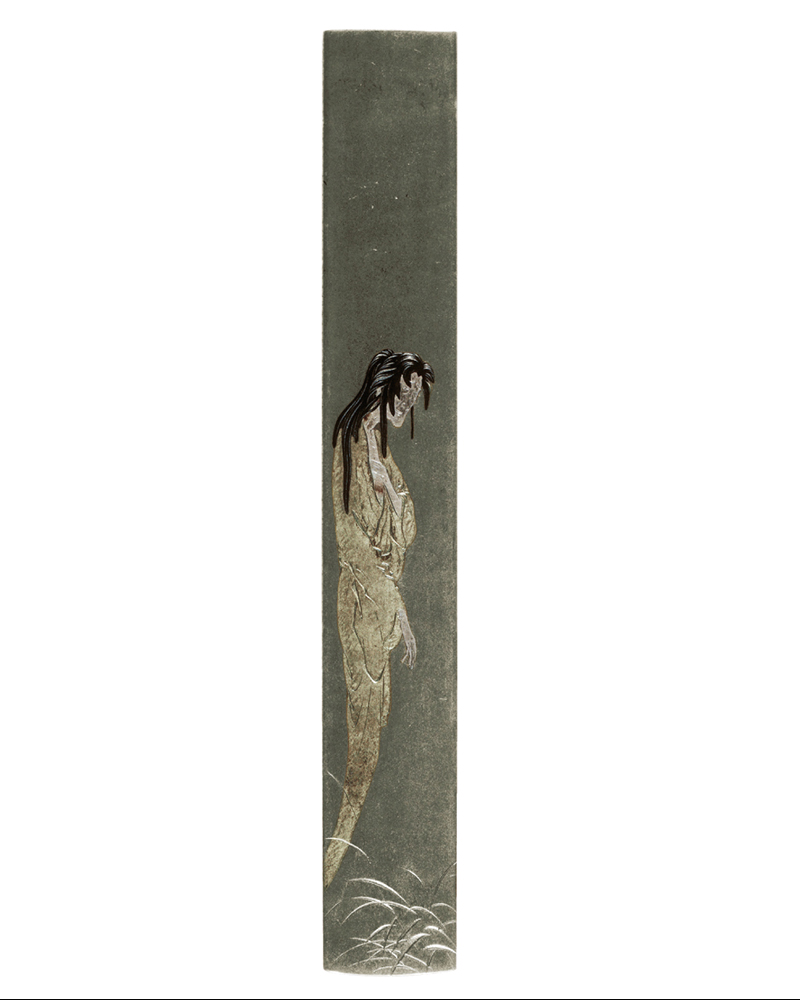
author
Natsuo Kano
Years of birth and death
1828-1898
Country
Japan
Era
Edo period, 1864
Traits
Obscured silver horizontal inlay
Number of members
1 share
Law
Length 9.6 cm Width 1.4 cm
Commentary
In the faint moonlight, a legless ghost emerges. The ghost is inlaid on a hazy silver background, and is made with a combination of several metals, including copper and silver, and even the wrinkles in the kimono, the hair, and the gloomy expression are depicted in the katakiribori. A willow tree is carved into the reverse side. This masterpiece, which is less than 10cm long, seems to depict even the night air with only metal.
Kano Natsuo was a master metalworker who represented the world of metalworking from the end of the Edo period to the beginning of the Meiji period. He produced sword fittings until the beginning of the Meiji period, and during that period he became the first Imperial Household Artist and a professor at the Tokyo School of Fine Arts (now Tokyo University of the Arts), where he mentored many young artists. He placed great importance on sketching and established his own unique style with lively and elegant depictions of plants and animals.
Autumn Grass and Insects, Set of Large and Small Metal Fittings
(Autumn grass, full of insects, complete set of flowers)

author
Goto Ichijo
Years of birth and death
1791–1876
Country
Japan
Era
Edo period (19th century)
Traits
Hairpin, small handle, edge/Shakudo gyogoko ground carved
Menuki/Shakudo Yobori
Number of members
1 set
Law
笄/Length 21.3 cm
Small/Long 9.5 cm
Edge/Width 2.1 cm Length 3.9 cm
Menuki (dragonfly) / Width 1.5 cm Length 4.3 cm
Commentary
The set includes a kozuka, a hairpin, two large and small rims, and two sets of menuki, and is decorated with autumn grasses and autumn insects. The kozuka, hairpin, and rim are elegantly engraved with takabori color paintings of dragonflies and butterflies playing among autumn grasses such as chrysanthemums, Usu, and Lady's mantle on the orderly, finely grained shakudo gyokoji, a characteristic of Ichijo's work, and the two sets of menuki are realistically and gracefully carved with butterflies, dragonflies, bell crickets, crickets, and locusts. Goto Ichijo was the last master craftsman of the Goto family, a distinguished family of metalworkers that served the Shogunate since the Muromachi period. He also excelled in painting, and with the high formality of the Goto family tradition and his own elegant and refined pictorial style, he is one of the leading metalworkers of the late Edo and Meiji periods, along with Kano Natsuo.
